John Seymour (1474–1536)
| Sir John Seymour Knight banneret | |
|---|---|
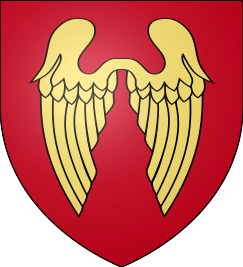 Arms of Seymour: Gules, two wings conjoined in lure or | |
| Born |
John Seymour c. 1474 |
| Died | 21 December 1536 (aged 61–62) |
| Resting place |
Church of St Mary, Great Bedwyn 51°22′37″N 1°36′09″W / 51.3769°N 1.6026°W |
| Occupation | English courtier |
| Known for | Father of Jane Seymour, Queen consort of Henry VIII of England |
| Spouse(s) | Margery Wentworth |
| Children |
John Seymour Edward Seymour, 1st Duke of Somerset Sir Henry Seymour Thomas Seymour, 1st Baron Seymour of Sudeley John Seymour Anthony Seymour Jane, Queen of England Margery Seymour Elizabeth Seymour, Lady Cromwell Dorothy Seymour |
| Parent(s) |
John Seymour Elizabeth Darrell |
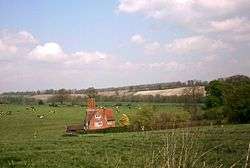
Sir John Seymour of Wulfhall in the parish of Great Bedwyn in the Savernake Forest, Wiltshire, Knight banneret (c. 1474[1][2] – 21 December 1536[3]) was an English soldier and a courtier who served both Henry VII and Henry VIII. Born into a prominent gentry family, he is best known as the father of the Henry VIII's third wife, Jane Seymour, and hence grandfather of king Edward VI of England.[4]
Family
The Seymours were descendants of an Anglo-Norman family that took its name from St. Maur-sur-Loire in Touraine. William de St. Maur in 1240 held the manors of Penhow and Woundy (now called Undy in Monmouthshire). William's great-grandson, Sir Roger de St. Maur, had two sons: John, whose granddaughter conveyed these manors by marriage into the family of Bowlay of Penhow, who bore the Seymour arms; and Sir Roger (c.1308 – Before 1366), who married Cicely, eldest sister and heir of John de Beauchamp, 3rd Baron Beauchamp. Cicely brought to the Seymours the manor of Hache, Somerset, and her grandson, Roger Seymour, by his marriage with Maud, daughter and heir of Sir William Esturmy, acquired Wulfhall (or Wolf Hall) in Wiltshire.[5] Sir John Seymour, was a great-great-grandson of this Roger Seymour.[4]
Sir John Seymour, was born around 1474,[1][2] the eldest son of John Seymour (c. 1450 – 26 October 1491) of Wulfhall, Wiltshire, by his marriage to Elizabeth Darell (or Darrell) (born c. 1451). He married Margery, the daughter of Sir Henry Wentworth of Nettlestead, Suffolk, and his wife Anne Say.[4] Anne was the daughter of Sir John Say and his wife, Elizabeth, daughter of Lawrence Cheney (or Cheyne) (c.1396–1461) and Elizabeth Cokayne.[4] Margery Wentworth's grandfather, Sir Philip Wentworth, had married Mary, daughter of John Clifford, 7th Baron de Clifford, whose mother Elizabeth was daughter of Henry Percy (Hotspur) and great-great-granddaughter of Edward III.[6] Margery was renowned for her beauty as well as her quiet and gentle demeanour, and she came to the attention of the poet, John Skelton.[7]
Career
He succeeded his father in 1492 and was knighted in the field by Henry VII for his services against the Cornish rebels at Blackheath on 17 June 1497.[8] He was made Knight banneret in 1513.[4] He was present at the sieges of Thérouanne and Tournay in 1513 as well as the two meetings between Henry VIII and Francis I:– the Field of the Cloth of Gold in 1520 and again in 1532. [9]
Offices held
His offices included:[9]
- Warden, Savernake Forest, Wiltshire October 1491
- Sheriff, Wiltshire 1498–1499, 1507–1508, 1518–19, 1524 – January 1526
- Sheriff of Somerset and Dorset 1515–1516, 1526–1527
- Justice of the peace Wiltshire 1499–1536
- Steward, Edward Stafford, 3rd Duke of Buckingham's lands, Wiltshire by 1503
- Knight of the body by 1509
- Constable and door-ward, Bristol Castle, Gloucestershire August 1509, jointly. (with son Edward) July 1517
- Under captain, Dragon of Greenwich 1512
- Commissioner subsidy, Wiltshire 1512, 1514, 1515, Wiltsshire and Salisbury 1523
- Commissioner musters, Wiltshire 1513
- Commissioner loan 1524
- Steward, manor of Kingston Lisle, Berkshire before 1513
- Forester, Grovely, Wiltshire February 1526
- Groom of the Bedchamber 1532
Marriage and Issue
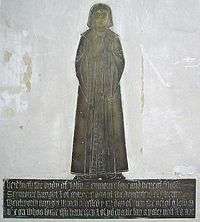
Sir John Seymour (1474–21 December 1536),[3][2] of Wulfhall, Savernake, Wiltshire, married Margery Wentworth (c.1478–18 October 1550) on 22 October 1494.[10] The couple had ten children: [10][11]
- John Seymour (died 15 July 1510),[12][13] eldest son and heir apparent who predeceased his father without progeny. His monumental brass survives set into the floor of Great Bedwyn Church, inscribed as follows:[14]
- "Here lyeth the body of John Seymour sonne and here of Sr John Seymour, Knight, & of Margery oon of the daughters of Sr Henry Wentworth, Knight, which decessed ye xv day of July the yer of or Lord MVCX on whos soule Jh(es)u have m(er)cy & of yor charitie say a Pater Nost(er) & a Ave (Maria)"
- Edward Seymour, 1st Duke of Somerset, Lord Protector of Edward VI (c. 1500[15]/1506[4] – 22 January 1552)[16] married firstly Catherine, daughter of Sir William Filliol[4] and secondly Anne, daughter of Sir Edward Stanhope.[4]
- Sir Henry Seymour (1503–1578) married Barbara, daughter of Morgan Wolfe[17]
- Thomas Seymour, 1st Baron Seymour of Sudeley (c. 1508 – 20 March 1549) married Catherine Parr, widow of Henry VIII[18][19]
- John Seymour (died young)[20]
- Anthony Seymour (died c. 1528)[12]
- Jane Seymour, queen Consort of Henry VIII (c. 1509 – 24 October 1537)[21][10]
- Margery Seymour (died c. 1528)[12]
- Elizabeth Seymour, Lady Cromwell (c. 1518[22] – 19 March 1568[23])
- Dorothy Seymour (c. 1519– )[20] married firstly, Sir Clement Smith (c. 1515 – 26 August 1552), MP, of Little Baddow, Essex[13][24] and secondly, Thomas Leventhorpe of Shingle Hall,[25] Hertfordshire.[20][26]
Of the ten children born at Wulfhall, six survived:– three sons: Edward, Henry and Thomas, and three daughters: Jane, Dorothy and Elizabeth. Edward, Thomas, Jane and Elizabeth were courtiers. Edward and Thomas, would both be executed during the reign of Edward VI. Henry Seymour, who lacked his brothers' ambition, lived away from court, in relative obscurity.[17]
He also had an illegitimate son:[27][28][29]
- Sir John Seymour (c. 1530 – before August 1599[27]), married in March 1568 Jane or Joan Poyntz, daughter of Sir Nicholas Poyntz and Joan Berkeley.[27][30]
Notable children
Four of the Seymour children achieved prominence at the royal court:– Edward, Thomas, Jane and Elizabeth.
Jane Seymour, the eldest surviving daughter, was a maid of honour of Henry's first wife, Catherine of Aragon, and then later of Anne Boleyn. Henry VIII stayed at Wulfhall with Queen Anne in the summer of 1535 for a few days.[31] In early 1536, Henry declared his love for Jane and began spending increasing amounts of time with her, chaperoned by her brother, Edward. Henry and Jane were officially betrothed the day after Anne Boleyn was arrested and executed on charges of treason, adultery and incest. After Jane became queen on 30 May 1536, her family scaled the social ranks, as was befitting the family of a royal consort.
Her eldest brother, Edward, was made an earl and eventually a duke and briefly ruled England on behalf of his nephew, King Edward VI. Her second brother, Thomas, was made a baron and Lord High Admiral, and in 1547 eloped with Henry VIII's widow, Queen Catherine Parr. Both Edward and Thomas were beheaded for treason, a few years apart.
Seymour's second daughter, Elizabeth, was first married to Sir Anthony Ughtred (c.1478 – 1534), secondly to Gregory Cromwell (c.1520 – 1551), son of Henry VIII's chief minister, Thomas Cromwell, and for a third time to John Paulet, Baron St John (c.1510 – 1576), who succeeded his father as Marquess of Winchester in 1572.
 Edward Seymour, 1st Earl of Hertford, later 1st Duke of Somerset & Lord Protector
Edward Seymour, 1st Earl of Hertford, later 1st Duke of Somerset & Lord Protector Thomas Seymour, 1st Baron Seymour of Sudeley
Thomas Seymour, 1st Baron Seymour of Sudeley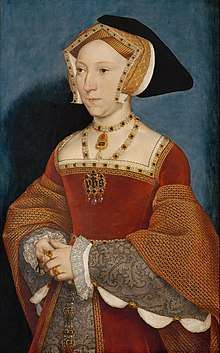 Jane Seymour, Queen of England, Hans Holbein the Younger
Jane Seymour, Queen of England, Hans Holbein the Younger_-_Portrait_of_a_lady%2C_probably_of_the_Cromwell_Family_formerly_known_as_Catherine_Howard_-_WGA11565.jpg) Portrait of a Lady, possibly Elizabeth Seymour[22]
Portrait of a Lady, possibly Elizabeth Seymour[22]
Death and burial
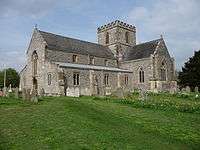
Seymour died on 21 December 1536.[9] By royal custom, his daughter Queen Jane did not attend the funeral.[3] He was first buried in the church of Easton Priory, but following the collapse of that building was reburied in 1590 by his grandson, Edward Seymour, 1st Earl of Hertford, in the church of Great Bedwyn,[32][33] the parish church of Wulfhall, where survives his monument.[34][35] His eldest son and heir, Edward Seymour, inherited lands to the annual value of £275.[9]
Monument, Great Bedwyn
His Monument in Great Bedwyn Church consists of a chest tomb displaying heraldic escutcheons, surmounted by his recumbent effigy, fully dressed in armour with hands in prayer, his head resting on his helm from which projects the sculpted Seymour crest of a pair of wings. His feet rest on a lion and a sword lies by his side.[36] On the wall above is fixed a tablet inscribed as follows:[37]
- "Here lyeth intombed the worthie Sr John Seymour of Wolfhall, Knight, who by Margerie his wyfe, daughter of Sr Henry Wentworthe, Knight, from whome the nowe Lorde Wentworthe is discended, had sixe sonnes and fower daughters, to wete, John who dyed unmaryed; Edwarde, Duke of Somerset, Earl of Hertforde, Vicount Beauchampe and Baron Seymour, uncle to Kinge Edwarde the Sixt, Governor of his Royall Person, Protector of all his Dominions and Subjects, Lorde Treasorer and Earle Marshall of Englande; w(i)ch Duke maryed Anne, daughter of Sr Edwarde Stanhope, Knight, by Elizabeth his wyfe, daughter of Sr Foulke Burgchier, Lorde Filzwaryn, (sic) from whome the moderne Earles of Bathe are discended; Sr Henry Seymour, Knight, who maried Barbara daughter of Thomas Morgan, Esquier; Thomas Lorde Seymour of Sudeley, Highe Admirall of Englande, who maryed Katherine, Queene of Englande, and wydow to Kinge Henry the Eight. One other Jhon, and Anthony, who dyed in theire infancy. Jane Qveene of Englande, wyfe to Kynge Henry the Eight, and mother to Kynge Edwarde the Sixt; Elizabeth, firste maryed to Sr Henry Ughtred,(sic) Knight, after to Gregorie, Lorde Cromwell, and last to Jhon Lorde Sainct John of Basinge,(sic) after Marquesse of Winchester; Margery, who dyed in her infancy, and Dorothe, maryed to Sr Clement Smythe, Knight. This Knight departed this lyfe at LX yeares of age, the XXI day of December, Anno 1536, and was firste buryed at Eston Priorie Churche amongst divers of his auncestors, bothe Seymours and Sturmyes. Howbeit that Churche beinge ruyned, and thereby all theire monumentes either whollie spoyled, or verie much defased duringe the mynoritie of Edwarde, Earle of Hertforde, sonne to the said Duke, the said Earle after, as well for the dutyfull love he beareth to his said grandefather, as for the better contynuans of his memory, did cause his bodie to be removed, and here to be intombed at his own coste and chardge, the laste daye of September, Anno 1590, in the XXXII yeare of the moste happye raigne of our gratious Soveraigne Ladie Queene Elizabeth."
A transcript was made of the inscriptions of the Seymour monuments by the topographer John Aubrey on his visit to the church in 1672, who also recorded the heraldry on the monument at that date, much of which has been lost.[38]
Notes
- 1 2 Norton 2009, p. 7.
- 1 2 3 Aubrey 1862, p. 375–376:John Seymour's monument gives his age as 60 which points to a birth year of 1476. "This Knight departed this Lyfe at LX years of age, the XXI day of December, Anno 1536 ..."
- 1 2 3 Norton 2009, p. 125–126.
- 1 2 3 4 5 6 7 8 Pollard 1897, pp. 299–310.
- ↑ Roskell & Knightly 1993.
- ↑ Seymour 1972, p. 18.
- ↑ Norton 2009, pp. 9–10.
- ↑ Loades 2013, p. 20.
- 1 2 3 4 Davids 1982.
- 1 2 3 Norton 2009, p. 11.
- ↑ Richardson, Magna Carta Ancestry III 2011, p. 111.
- 1 2 3 Norton 2009, p. 13.
- 1 2 Aubrey 1862, p. 377.
- ↑ Frederic Madden, Bulkeley Bandinel, John Gough Nichols, (Eds.), Collectanea Topographica Et Genealogica, Vol.5, pp.21–24
- ↑ Beer 2009.
- ↑ Pole 2008, p. 481.
- 1 2 Hawkyard 1982b.
- ↑ Hawkyard 1982c.
- ↑ Seymour 1972, p. 65.
- 1 2 3 Burke III 1836, p. 201.
- ↑ Wagner & Schmid 2012, p. 1000.
- 1 2 Strong 1967, pp. 278–281: "The portrait should by rights depict a lady of the Cromwell family aged 21 c.1535–40..."
- ↑ College of Arms 2012, p. 63.
- ↑ Machyn 1848, p. 24, 326.
- ↑ Shingle Hall is also listed as Shingey, Shingley and Shinglehall in various sources.
- ↑ Richardson, Plantagenet Ancestry III 2011, p. 82.
- 1 2 3 MacLean 1887, p. 152, Will proved 4 August 1599
- ↑ Seymour 1972, p. 26.
- ↑ Chitty 1885, p. 129.
- ↑ Burke 1965, p. 581.
- ↑ Lauder 2002, p. 138.
- ↑ Aubrey 1862, p. 374–375.
- ↑ Sherlock 2008, p. 34, 36.
- ↑ http://www.british-history.ac.uk/vch/wilts/vol16/pp8-49#h3-0027
- ↑ For description of monument and transcript of inscription see: Collectanea Topographica Et Genealogica, Volume 5 edited by Frederic Madden, Bulkeley Bandinel, John Gough Nichols, pp.21–24 . For images see:
- ↑ http://www.britishlistedbuildings.co.uk/en-310806-church-of-st-mary-the-virgin-great-bedwy#.VlSeNL94Mqc
- ↑ Text from: Frederic Madden, Bulkeley Bandinel, John Gough Nichols, (Eds.), Collectanea Topographica Et Genealogica, Vol.5, pp.21–24, corrected from observation of photograph
- ↑ Aubrey,John, An Essay Towards the Description of the North Division of Wiltshire, 1672, (ed. Sir T. Phillipps), 1838 Edition, pp.72–4
- Attribution


References
- Aubrey, John; Jackson, John Edward (1862). Wiltshire: The Topographical Collections of John Aubrey, F. R. S., A. D. 1659–70, With Illustrations. Corrected and enlarged by John Edward Jackson. London: Wiltshire Archaeological and Natural History Society.
- Beer, Barrett L. (2004). "Jane [née Jane Seymour] (1508/9–1537)". Oxford Dictionary of National Biography (online ed.). Oxford University Press. doi:10.1093/ref:odnb/14647. (Subscription or UK public library membership required.)
- Beer, Barrett L. (January 2009) [First published 2004]. "Seymour, Edward, duke of Somerset (c.1500–1552)". Oxford Dictionary of National Biography (online ed.). Oxford University Press. doi:10.1093/ref:odnb/25159. (Subscription or UK public library membership required.)
- Bernard, G. W. (May 2011) [First published 2004]. "Seymour, Thomas, Baron Seymour of Sudeley (b. in or before 1509, d. 1549)". Oxford Dictionary of National Biography (online ed.). Oxford University Press. doi:10.1093/ref:odnb/25181. (Subscription or UK public library membership required.)
- Bindoff, S. T. (1982). "Cromwell, Thomas (by 1485–1540), of London". In Bindoff, S. T. Members. The History of Parliament: The House of Commons 1509–1558. 1: Appendices, constituencies, members A–C. London: Published for the History of Parliament Trust by Secker & Warburg. ISBN 0436042827.
- Burke, Bernard (1965). Townend, Peter, ed. Burke's Genealogical and Heraldic History of the Landed Gentry. Edited by Peter Townend (18th ed.). London: Burke's Peerage. ASIN B0006BNKM8.
- Burke, John (1836). A Genealogical and Heraldic History of the Commoners of Great Britain and Ireland, Enjoying Territorial Possessions or High Official Rank; But Invested With Heritable Honours. III. London: Published for Henry Colburn by R. Bentley.
- Carthew, G. A. (1878). The Hundred of Launditch and Deanery of Brisley; in the County of Norfolk; Evidences and Topographical Notes from public records, Heralds' Visitations, Wills, Court Rolls, Old Charters, Parish Registers, Town books, and Other Private Sources; Digested and Arranged as Materials for Parochial, Manorial, and Family History. II. Collected by G.A. Carthew. Norwich: Printed by Miller and Leavins.
- Chitty, Henry; Phillipot, John (1885). MacLean, John; Heane, W. C., eds. The Visitation of the County of Gloucester, Taken in 1623, by Henry Chitty and John Phillipot as Deputies to William Camden, Clarenceux King of Arms, With Pedigrees from the Heralds' Visitations of 1569 and 1582–3, and Sundry Miscellaneous Pedigrees. Publications of the Harleian Society. XXI. Edited by Sir John MacLean, F.S.A., etc., and W. C. Heane, M.R.C.S., etc. London: Harleian Society.
- Cokayne, G. E. (1913). Gibbs, Vicary; Doubleday, H. Arthur, eds. The Complete Peerage of England, Scotland, Ireland, Great Britain and the United Kingdom, Extant, Extinct or Dormant. III. London: St. Catherine Press.
- Cokayne, G. E. (2000). Gibbs, Vicary; Doubleday, H. A.; White, Geoffrey H.; Warrand, Duncan; Lord Howard de Walden, eds. The Complete Peerage of England, Scotland, Ireland, Great Britain and the United Kingdom, Extant, Extinct or Dormant. III (new ed.). Gloucester: Alan Sutton Publishing. pp. 555, 557–558.
- Cokayne, G. E. (1916). Gibbs, Vicary, ed. The Complete Peerage of England, Scotland, Ireland, Great Britain and the United Kingdom, Extant, Extinct or Dormant. IV. London: St. Catherine Press.
- Cokayne, G. E. (1898). Complete Peerage of England, Scotland, Ireland, Great Britain and the United Kingdom, Extant, Extinct or Dormant. VIII. Exeter: William Pollard.
- Colby, Frederic Thomas, ed. (1872). The Visitation of the County of Devon in the Year 1620. Publications of the Harleian Society. VI. Edited by Frederic Thomas Colby. London: Printed by Taylor and Co.
- College of Arms (1829) [Printed by S. and R. Bentley, London, 1829]. Catalogue of the Arundel Manuscripts in the Library of the College of Arms. [By William Henry Black. With a preface signed C. G. Y., i.e. Sir Charles George Young]. Rarebooksclub.com (published 20 May 2012). ISBN 9781236284259.
- Dasent, John Roche, ed. (1892) [First published HMSO:1892]. Acts of the Privy Council of England. New Series. IV: 1552–1554. British-history.ac.uk. Retrieved 18 April 2014.
- Davids, R. L. (1982). "Seymour, Sir John (1473/74–1536), of Wolf Hall, Wilts.". In Bindoff, S. T. Members. The History of Parliament: the House of Commons 1509–1558. Historyofparliamentonline.org. Retrieved 10 March 2014.
- Faris, David (1999). Plantagenet Ancestry of Seventeenth-Century Colonists: The Descent from the Later Plantagenet Kings of England, Henry III, Edward I, Edward II, and Edward III, of Emigrants from England and Wales to the North American Colonies Before 1701 (2nd ed.). Boston: New England Historic Genealogical Society. ISBN 0880821078.
- Flower, William (1881). Norcliffe, Charles Best, ed. The Visitation of Yorkshire in the Years 1563 and 1564, Made by William Flower, Esquire, Norroy king of Arms. Publications of the Harleian Society. XVI. Edited by Charles Best Norcliffe. London: Mitchell and Hughes, Printers.
- Fuidge, N. M. (1981). "Ughtred, Henry (by 1534–aft. Oct. 1598), of Southampton and Ireland". In Hasler, P. W. Members. The History of Parliament: The House of Commons 1558–1603. Historyofparliamentonline.org. Retrieved 19 April 2014.
- Hawkyard, A. D. K. (1982). "Cromwell, Gregory (by 1516–51), of Lewes, Suss.; Leeds Castle, Kent and Launde, Leics.". In Bindoff, S. T. Members. The History of Parliament: the House of Commons 1509–1558. Historyofparliamentonline.org. Retrieved 19 April 2014.
- Hawkyard, A. D. K. (1982). "Seymour, Sir Henry (by 1503–78), of Marwell, Hants.". In Bindoff, S. T. Members. The History of Parliament: the House of Commons 1509–1558. Historyofparliamentonline.org. Retrieved 10 March 2014.
- Hawkyard, A. D. K. (1982). "Seymour, Sir Thomas II (by 1509–49), of Bromham, Wilts., Seymour Place, London and Sudeley Castle, Glos.". In Bindoff, S. T. Members. The History of Parliament: the House of Commons 1509–1558. Historyofparliamentonline.org. Retrieved 10 March 2014.
- "Journal of the House of Lords". British-history.ac.uk. Retrieved 19 April 2014.
- Lauder, Rosemary (2002). Devon Families. Tiverton: Halsgrove. ISBN 1-84114-140-2.
- Leithead, Howard (2008) [First published 2004]. "Cromwell, Thomas, Earl of Essex (b. in or before 1485, d. 1540)". Oxford Dictionary of National Biography (online ed.). Oxford University Press. doi:10.1093/ref:odnb/6769. (Subscription or UK public library membership required.)
- "Letters and Papers, Foreign and Domestic, Henry VIII". British-history.ac.uk. Retrieved 3 March 2014.
- Loades, David (2013). Jane Seymour: Henry VIII's Favourite Wife (hardback). Stroud: Amberley. ISBN 9781445611570.
- Machyn, Henry (1848). Nichols, John Gough, ed. The Diary of Henry Machyn, Citizen and Merchant–Taylor of London, from A. D. 1550 to A. D. 1563. [Camden Society. Publications]. XLII. Edited by John Gough Nichols. London: Printed for the Camden Society by J. B. Nichols and Son.
- MacLean, John (1887). "Manor of Tockington and the Roman Villa". In Maclean, John. Transactions of the Bristol & Gloucestershire Archaeological Society, For 1887–88. XII. Edited by Sir John MacLean, F.S.A., &c. Bristol and Gloucestershire Archaeological Society. pp. 123–169.
- MacMahon, Luke (2004). "Ughtred, Sir Anthony (d. 1534)". Oxford Dictionary of National Biography (online ed.). Oxford University Press. doi:10.1093/ref:odnb/27979. (Subscription or UK public library membership required.)
- N. M. S. (1981). "Cromwell, Thomas (c.1540–c.1611), of king's Lynn, Norf.". In Hasler, P. W. Members. The History of Parliament: the House of Commons 1509–1558. Historyofparliamentonline.org. Retrieved 4 March 2014.
- Noble, Mark (1784). Memoirs of Several Persons and Families Who, by Females are Allied to, or Descended from the Protectorate–House of Cromwell. Birmingham: Pearson and Rollason.
- Norris, Herbert (1998). Tudor Costume and Fashion. With a new introduction written by Richard Martin (new ed.). New York: Dover Publications. ISBN 0486298450.
- Norton, Elizabeth (2009). Jane Seymour: Henry VIII's True Love (hardback). Chalford: Amberley Publishing. ISBN 9781848681026.
- Pole, Reginald; Mayer, Thomas F.; Walters, Courtney B. (2008). A Biographical Companion: The British Isles (hardback). The Correspondence of Reginald Pole. 4. By Thomas F. Mayer and Courtney B. Walters. St Andrews Studies in Reformation History. Aldershot: Ashgate Publishing. ISBN 9780754603290.
- Pollard, Albert Frederick (1897). "Seymour, Edward". In Lee, Sidney. Dictionary of National Biography. 51. London: Smith, Elder & Co. pp. 299–310.
- Richardson, Douglas (2011). Everingham, Kimball G., ed. Magna Carta Ancestry: A Study in Colonial and Medieval Families. III (2nd ed.). CreateSpace. ISBN 1461045207.
- Richardson, Douglas (2011). Everingham, Kimball G., ed. Plantagenet Ancestry: A Study in Colonial and Medieval Families. III (2nd ed.). CreateSpace. ISBN 1461045134.
- Roskell, J. S.; Knightly, Charles (1993). "Sturmy (Esturmy), Sir William (c.1356–1427), of Wolf Hall in Great Bedwyn, Wilts. and Elvetham, Hants.". In Roskell, J. S.; Clark, C. Rawcliffe. Members. The History of Parliament: the House of Commons 1386–1421. Historyofparliamentonline.org. Retrieved 11 March 2014.
- Russell, Gareth (14 May 2010). "May 14th, 1536: Mistress Seymour's New Lodgings". Confessions of a Ci-Devant. Garethrussellcidevant.blogspot.com.au. Retrieved 3 April 2014.
- Schofield, John (2011). The Rise & Fall of Thomas Cromwell: Henry VIII's Most Faithful Servant. The History Press. ISBN 978-0-7524-5866-3.
- Seymour, William (1972). Ordeal by Ambition: An English Family in the Shadow of the Tudors. London: Sidgwick & Jackson. ISBN 028397866X.
- Sherlock, Peter (2008). Monuments and Memory in Early Modern England. Burlington: Ashgate Publishing. ISBN 978-0-7546-6093-4.
- Starkey, David (2004). Six Wives: The queens of Henry VIII. London: Vintage. ISBN 9780099437246.
- Strong, Roy (May 1967). "Holbein in England – I and II". The Burlington Magazine. 109 (770): 276–281. JSTOR 875299.
- Strype, John (1822). Ecclesiastical Memorials. II. Oxford: Clarendon Press.
- Syvret, George S.; Carteret, Samuel de (1832). Chroniques des Iles de Jersey, Guernesey, Auregny et Serk (in French). Auquel on a ajouté un Abrégé Historique des dites Iles par Samuel de Carteret. Guernesey: de l'imprimerie de Thomas James Mauger.
- Thornton, Tim (2012). The Channel Islands, 1370–1640: Between England and Normandy. Woodbridge: The Boydell Press. ISBN 978-1-84383-711-4.
- Wagner, John A.; Schmid, Susan Walters (2012). Encyclopedia of Tudor England (hardback). 3. Santa Barbara: ABC-CLIO. ISBN 9781598842982.
- Wilson, Derek (2006). Hans Holbein: Portrait of an Unknown Man (revised ed.). London: Pimlico. ISBN 9781844139187.
External links
| Wikimedia Commons has media related to St Mary the Virgin's church, Great Bedwyn. |
- Seymour, Sir John (1473/74-1536), of Wolf Hall, Wilts. A biography
- Seymour Family A pedigree of the Seymour family
- John Seymour at Find a Grave
- Church of St Mary the Virgin, Great Bedwyn British Listed Buildings